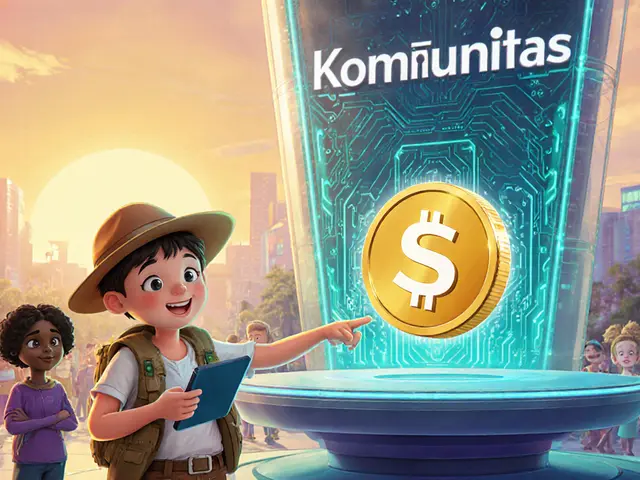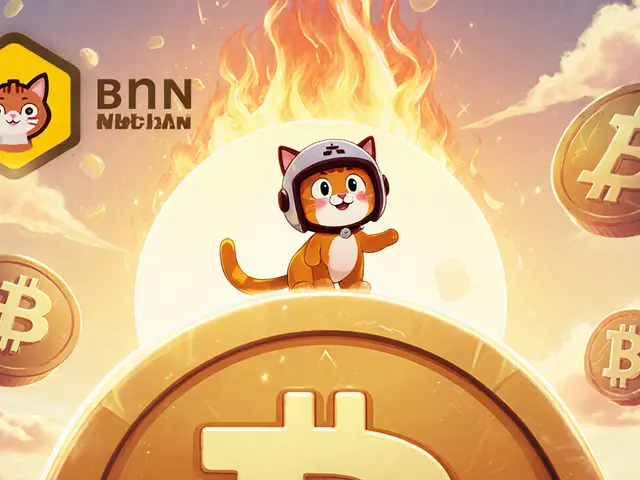KOM Airdrop Eligibility Calculator
Estimate Your Potential Airdrop Allocation
Calculate your estimated KOM token allocation based on your staking and engagement level.
Estimated Allocation
If you’ve been tracking early‑stage crypto projects, you’ve probably seen the name KOM airdrop pop up on forums and social feeds. Kommunitas, the decentralized launchpad behind the token, has run several airdrop campaigns since its launch in 2021, each with its own rules, rewards, and deadlines. This guide breaks down everything you need to know - from the token’s history and migration to BNB Chain, to how you can qualify for upcoming drops and what benefits holding $KOM actually brings.
What is Kommunitas and the $KOM Token?
Kommunitas is a tier‑less, decentralized launchpad that lets anyone invest in early‑stage crypto projects without the usual stake thresholds. The platform’s native utility token, $KOM, powers the ecosystem, granting users access to project allocations, staking rewards, and governance voting rights.
The $KOM token was initially deployed on the Polygon network (contract address 0xC004e2318722EA2b15499D6375905d75Ee5390B8) and later expanded to Arbitrum before the strategic migration to BNB Chain in June 2025. This move lowered transaction fees and positioned the launchpad on a high‑throughput blockchain, improving the user experience for both investors and project teams.
Why Do Airdrops Matter for KOM Holders?
Airdrops are Kommunitas' way of rewarding early supporters, spreading token awareness, and bootstrapping liquidity for new projects. For $KOM holders, participating in airdrops can boost your overall portfolio without any additional investment. Moreover, successful airdrop participation often unlocks extra benefits like increased staking yields or priority voting rights in upcoming governance proposals.

Historical KOM Airdrop Campaigns
Kommunitas has run three notable airdrop campaigns to date. Below is a quick snapshot that highlights the key differences.
| Campaign | Launch Date | Total Pool | Winners | Max Allocation per Winner |
|---|---|---|---|---|
| Initial Airdrop | August 2021 | 2,000,000 KOM | ~2,100 participants | 2,000 KOM (≈$20 at the time) |
| CM‑C Partnership | March 2023 | 3,000,000 KOM | 2,000 winners | 1,500 KOM |
| Copycat Finance Launch | January 2024 | 800,000 KOM | 800 participants | 1,000 KOM |
Each campaign required users to complete a set of simple tasks - typically joining the Telegram community, completing a KYC verification, and linking a wallet address. The most recent drops also asked participants to stake a minimum of 50KOM on the platform to qualify for the larger allocation tiers.
How to Qualify for Future KOM Airdrops
- Join the Official Channels: Follow Kommunitas on Telegram, Twitter, and Discord. Announcements about upcoming airdrops are posted there first.
- Complete KYC: A one‑minute verification using an email and a government ID ensures you’re eligible for compliance‑required drops.
- Connect a Compatible Wallet: Use MetaMask, Trust Wallet, or Binance Chain Wallet configured for BNB Chain. Make sure the wallet address matches the one used in the KYC form.
- Stake $KOM: While not always mandatory, staking 50-100KOM can boost your allocation and sometimes earns you bonus airdrop tickets.
- Engage with the Community: Completing surveys, sharing referral links, or participating in testnets can earn extra points that increase the chance of being selected.
Once you’ve completed these steps, you’ll receive an email with a unique claim link when the airdrop opens. The claim window typically lasts 48hours; after that, unclaimed tokens are re‑distributed.
Benefits of Holding $KOM Beyond Airdrops
Holding $KOM does more than line your wallet with airdrop payouts. Here’s a quick rundown of the utilities baked into the token:
- Guaranteed Project Allocation: Every $KOM holder can participate in new token sales on the launchpad without tier restrictions.
- Staking Rewards: Stake $KOM on the platform and earn a variable APY that has historically ranged between 6‑12%.
- Governance Rights: Token holders vote on which projects get listed, platform fee structures, and key protocol upgrades.
- Revenue Sharing: Successful projects generate fees that are partially redistributed to $KOM stakers as a passive income stream.
The tier‑less model means you don’t need to hold millions of tokens to get a spot in a high‑profile launch. Even a modest $KOM balance gives you a foot in the door.
Risks and Considerations
As with any crypto investment, there are risks to weigh before diving into KOM airdrops or staking. Price volatility is the most obvious - $KOM’s market price fluctuated between $0.005 and $0.12 in 2024. Regulatory shifts could affect the legality of airdrops in certain jurisdictions, and the success of the projects launched on Kommunitas directly impacts the token’s long‑term viability.
Kommunitas tries to mitigate these risks by vetting every project through a rigorous due‑diligence process, publishing transparent audit reports, and maintaining an active community that flags suspicious activity. Still, competition for allocation spots can be fierce during popular launches, meaning you might receive a smaller slice than expected.
Future Outlook for Kommunitas and $KOM
Looking ahead, the platform plans to expand its multi‑chain support beyond BNB Chain, adding options for Solana and Avalanche. This expansion could bring a broader range of projects, attracting more users and increasing demand for $KOM. The team also announced a roadmap for introducing a decentralized autonomous organization (DAO) governance layer, giving token holders even more direct control over platform decisions.
For airdrop enthusiasts, the key takeaway is that Kommunitas is likely to keep running periodic drops as a community‑building tool. By staying active on official channels, staking a modest amount of $KOM, and completing engagement tasks, you position yourself to benefit from the next wave of free tokens.
Frequently Asked Questions
How can I claim a KOM airdrop?
After completing the registration steps (KYC, wallet link, optional staking), you’ll receive an email with a claim URL. Click the link within the 48‑hour window, connect your BNB Chain wallet, and confirm the transaction. The tokens will appear in your wallet immediately.
Do I need to hold $KOM to participate in airdrops?
Holding $KOM isn’t mandatory for every airdrop, but many campaigns give bonus tickets or higher allocation caps to stakers. Keeping at least 50KOM staked on the platform maximizes your chances.
What wallets are compatible with the KOM token?
MetaMask, Trust Wallet, Binance Chain Wallet, and any wallet that supports BNB Chain (formerly Binance Smart Chain) can hold $KOM. If you’re still on Polygon or Arbitrum, you’ll need to bridge your tokens to BNB Chain after the June 2025 migration.
Is staking $KOM risky?
Staking itself isn’t technically risky - the tokens remain in a smart contract you control. The main risk is the token’s market price moving down while your funds are locked, which could offset the staking rewards.
Where can I find the latest KOM airdrop announcements?
The fastest sources are the official Telegram group, the @KommunitasTwitter account, and the Discord server’s #airdrop-announcements channel. The website’s “News” page also posts a weekly roundup.



Comments
Listen up, the KOM airdrop isn’t a coincidence, it’s a calculated move to lock in users while the token’s price hovers in the cheap‑to‑buy zone.
First, the migration to BNB Chain slashed fees, making it trivial for bots to flood the system and scoop up the low‑allocation slots.
Second, the engagement bonuses are deliberately vague, rewarding those who can game the referral system with sheer volume.
Third, the KYC step is just a veneer of compliance – it gives the project legal cover while still letting the core team cherry‑pick winners behind the scenes.
Fourth, the staking requirement of 50‑100 KOM is low enough to entice casual investors, yet high enough to lock up a significant token supply.
Fifth, the claim window of 48 hours creates panic, ensuring users act without doing proper due diligence.
Sixth, the historical volatility of $KOM, ranging from $0.005 to $0.12, is a perfect storm for speculative buying and dumping.
Seventh, the DAO roadmap is a narrative device to keep the community hopeful while the real revenue streams flow to early insiders.
Eighth, the cross‑chain expansion to Solana and Avalanche is marketed as growth but actually dilutes token value across multiple ecosystems.
Ninth, the revenue‑sharing model sounds generous, yet the fee percentages are buried in fine print that only auditors notice.
Tenth, the community governance votes often become popularity contests rather than genuine protocol upgrades.
Eleventh, the airdrop’s “tier‑less” promise is a marketing myth – the biggest allocations still go to whales who stake huge amounts.
Twelfth, the constant stream of Telegram and Discord announcements serves as a reminder that you’re always being watched.
Thirteenth, the token’s utility on the launchpad is limited to project allocations, which may never materialize into real value.
Fourteenth, the repeated airdrop cycles create a dependency trap, where users keep returning for free tokens instead of building sustainable portfolios.
Fifteenth, if you want to protect yourself, treat every airdrop as a promotional giveaway, not a financial strategy, and only allocate funds you can afford to lose.
Honestly, the whole airdrop hype is just a clever marketing ploy.
Hey, don’t let the hype blind you – use the calculator to see a realistic estimate before you stake.
Even a modest 100 KOM can net you a decent allocation if you hit the high engagement tier.
Remember, the KYC bonus adds only 10 % on top, so the bulk comes from your base and engagement.
Stay disciplined, set a cap on how much you’re willing to lock, and treat the airdrop as a bonus, not a primary income.
The airdrop mechanism reflects a deeper philosophical shift in crypto – community‑driven value versus pure market speculation.
By staking, participants signal trust, which the protocol rewards, creating a feedback loop of engagement.
But this loop can become self‑referential, inflating token price without real utility.
Yo, ever notice how every time they say "secure your spot" it coincides with a sudden dip in the price?
It’s like they’re baiting us into buying low just before they dump the whale‑allocated tokens.
Also, the KYC form asks for weird info you don’t need – maybe they’re building a data‑farm.
Don’t trust the “transparent” roadmap, it’s full of buzzwords to mask the real agenda.
Keep your eyes peeled, the next claim window might be a trap.
The guide does a solid job outlining the steps, but I’d recommend double‑checking the wallet address before linking it to KYC.
A simple typo can cost you the entire allocation.
Also, consider the opportunity cost of staking 50 KOM versus potential returns from other DeFi protocols.
Alright, let’s break down why the KOM airdrop feels like a carnival ride.
The BNB Chain migration was a headline move, but underneath it’s about slashing gas so bots can flood the system.
Stake 50 KOM? Easy, but remember the “bonus tickets” are just a way to reward those who already have skin in the game.
The engagement tasks – surveys, referrals – are low‑effort for the team, high‑effort for us.
All in all, treat this as a promotional funnel: get in, do the tasks, cash out, and move on.
Don’t expect long‑term holding rewards unless you truly believe in the launchpad’s future projects.
The formal structure of the claim process is commendable; it provides clear checkpoints for participants.
However, the reliance on KYC introduces centralized risk that could be at odds with the ethos of decentralization.
Stakeholders should weigh this trade‑off when deciding their level of involvement.
You could argue that the multi‑chain expansion is a diversification strategy, yet it also fragments liquidity across ecosystems.
From a contrarian viewpoint, spreading thin may dilute the token’s utility and confuse users.
On the other hand, offering Solana and Avalanche options could attract a broader audience, boosting network effects.
Balance is key; too much expansion can undermine the core value proposition.
Did you see the hidden clause in the latest terms? They’re reserving the right to re‑allocate unclaimed tokens to “strategic partners,” which sounds like a backdoor for insiders.
That, plus the sudden surge in bot activity around the claim window, suggests a coordinated effort to soak up the easy tokens.
Keep an eye on transaction logs; you’ll notice large wallets popping up right after the airdrop opens.
Also, the KYC verification system was updated last week – could be a new data‑collection vector.
Stay vigilant, the platform may be more opaque than it appears.
I get the basics, but the whole thing feels a bit over‑engineered.
Probably just another way to get people to lock up their tokens.
From a rigorously analytical perspective, the tokenomics presented are mathematically sound, assuming the projected network growth holds true.
The revenue‑sharing mechanism, while modest, adds a tangible incentive for long‑term holders.
Nevertheless, the underlying market dynamics remain susceptible to external regulatory pressures.
Great guide! 🙌 I’m excited to try the calculator and see what I can snag. 🚀
The cultural shift toward community‑driven launchpads like Kommunitas reflects a broader desire for inclusive finance.
By offering tier‑less access, they lower barriers for emerging markets.
This could accelerate global participation in new crypto projects.
Philosophically, airdrops are a modern take on the concept of a universal basic income, albeit limited in scope.
They incentivize early adoption without demanding upfront capital.
While the exposition is thorough, one must scrutinize the underlying assumptions regarding token velocity and demand elasticity.
Absent a rigorous econometric model, predictions remain speculative at best.
Consequently, any investment thesis predicated solely on airdrop participation may lack substantive grounding.
Nevertheless, the narrative surrounding decentralized launchpads continues to captivate a niche yet growing demographic.